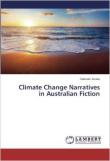AustLit
Latest Issues
AbstractHistoryArchive Description
'Several major Australian novels about climate change imagine a warmed planet. This is a timely survey of these cautionary tales. There is also a long tradition of Australians, settlers and Indigenous people, writing about the land and the sea, and about how our climate shapes our communities and our future, and about how colonisation and industrialisation too often destroys our environment. This outline begins to locate, question and frame the insights of many past and present Australian authors about changing climatic conditions.' (Publication summary)
Notes
-
Epigraph:
'One evening in the driest grasses in the world, a child who was no stranger to her people, asked if anyone could find hope. The people of parable and prophecy pondered what was hopeless and finally declared they no longer knew what hope was. The clocks, tick-a-ty tock, looked as though they might run out of time. Luckily, the ghosts in the memories of the old folk were listening, and said anyone can find hope in the stories. The big stories and the little stories and the ones in between. ’ — Alexis Wright, Carpentaria , p12
Contents
-
Introduction,
single work
criticism
(p. 3-10)
'‘Today’ writes Dipesh Chakrabarty, it is precisely the ‘survival of the species’ on a ‘world - wide scale’ that is in question and the question for ‘all progressive political thought’. 2 Again and again we are warned by the climate scientists that the human species faces one of its greatest challenges with the warming of the globe. The dire condition of our planet is now more widely recognised; that is the real ‘Eaarth’, 3 which is no longer a garden of Eden, nor pastoral paradise. Australia has warmed by approximately one degree since 1910 and most of the warming has occurred since 1970. 4 Humans barely qualify as an intelligent life form on the planetary scale, because environmental issues are ‘high on the extra -terrestrial age nda’ proposes Linda Jaivin in Rock n Roll Babes From Outer Space (1996). Our ‘barely’ intelligent human life form is responsible for global warming, massive pollution, species depletion and biodiversity loss, toxic methane release, melting ice-caps, increasing intensity of cyclones and rainfall, wildfires and dying forests. This consciousness of planetary change is reflected in recent cautionary climate change narratives; it is timely to re-examine our understandings of the role of the environmental imagination in Australian literature. What follows is merely a preliminary exploration, mere field notes on the approaching catastrophe.' (Author's introduction, 3)
-
Climate Change Novels,
single work
criticism
(p. 15-32)'Climate Scientists warn of the dangers of global warming. How are Australian writers responding to this crisis? The first section of the book examines the stories by women and men writers directly about climate change scenarios. Notable authors are George Turner and Alexis Wright. ' (15)
-
How Do We Define the Climate Change Novel?,
single work
criticism
(p. 33-40)'How do we best define a climate change novel? Given the complexities of climate change, as a real, scientific and cultural phenomenon, global warming demands a corresponding degree of complexity in fictional representation. Recent popular debates here and overseas raise further questions about what exactly constitutes a climate change novel. Does a climate change novel need to be set in the present? Or set in the future? Set during the time of climate change and extreme weather events, and the associated food scarcity and water wars, or can it be well after that —such as George Turner’s iconic The Sea and Summer? Are these novels best framed in context of utopian studies and science fiction studies? Andrew Milner has contextualised The Sea and Summer in terms of understanding the history of Australian science-fictional dystopias. For him, science fiction, whether utopian or dystopian , is ‘as good a place as any’ for ‘thought experiments about the politics of climate change’. He rejects the widespread ‘academic prejudice in literary studies against science fiction dystopias’ arguing that science fiction cannot readily be assimilated into either high literature or popular fiction (as genre). ' (33)
-
Human's Changing Relationship to the Non-Human World,
single work
criticism
(p. 41-55)'The environmental crises the human species faces are urgent. When the climate change literary critics Adam Trexler and Adeline John-Putra argue that climate change calls for a fundamental re-valuation of ourselves, even while it challenges us to put to use the critical cultural tools we have, 77 they are right. A fundamental re-evaluation is needed in face of the urgency, seriousness, complexity, immediacy, duration and global scope of the problems facing the human species. In the previous pages we have looked albeit briefly at some of the key novels addressing climate change scenarios which we can identify in Australian writing. Can the critics help us refine our concepts a little further?' (41)
-
New Worlds, Old Worlds : Australian Literature in a Global Context,
single work
criticism
(p. 56-75)'Australia and other settler colonies need to address complex problems in unpacking historical divides between culture and nature, humans and non-humans, arts and science, tradition and modernity, and male and female, even conscious and unconscious anthropogenic agents. These divides are thrown into especially stark relief in Australia, as one of the last formed settler colonies, with its dual cultures. Differences in approaches to the environment could hardly have been greater. On the one hand is the history of adaptation (and maladaptation) to rapid changes in the environment of its European settlers, both on the individual level through the shocks of rupture and disconnection through the experience of migration, and on the wider community level with the loss of biodiversity, through both introduction of European species and species extinction, of planting of commercial timber and de-forestation of old growth forests.' (56)




